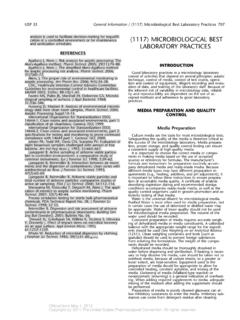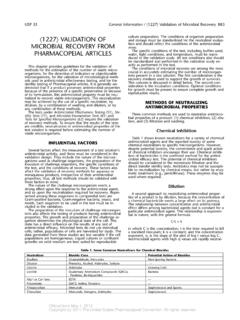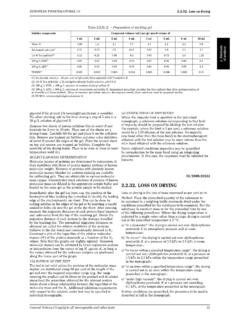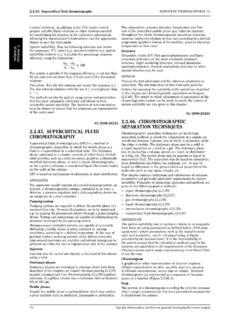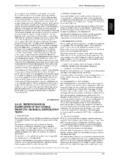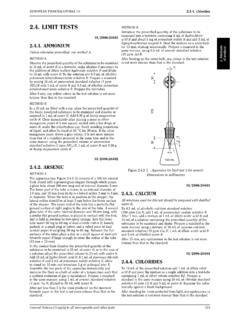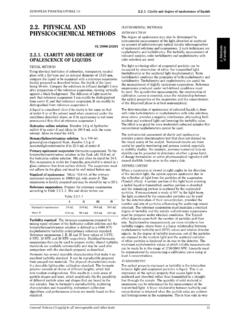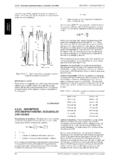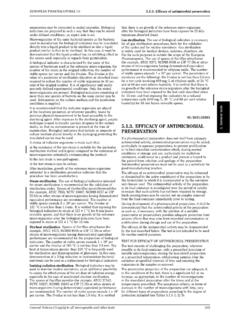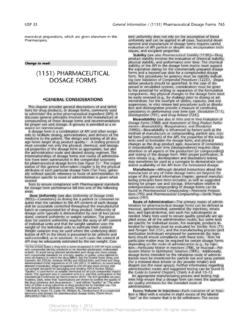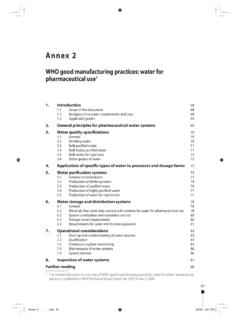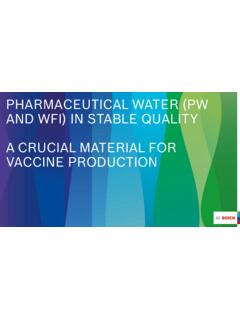Transcription of <1231> WATER FOR PHARMACEUTICAL PURPOSES
1 First Supplement to USP 35 NF 30 General Information / 1231 WATER for PHARMACEUTICAL Purposes5219incident on the sample and includes losses due to solventnature of this raw material. Microbial specifications are typi-absorption, refraction, and scattering; and A is thecally assessed by test methods that take at least 48 to to generate results. Because PHARMACEUTICAL watersare generally produced by continuous processes and used inproducts and manufacturing processes soon after genera-tion, the WATER is likely to have been used well before defini-tive test results are available. Failure to meet a compendialspecification would require investigating the impact andmaking a pass/fail decision on all product lots between theprevious sampling s acceptable test result and a subsequent 1231 WATER FORsampling s acceptable test result.
2 The technical and logisticalproblems created by a delay in the result of such an analysisPHARMACEUTICAL PURPOSESdo not eliminate the user s need for microbial , such WATER systems need to be operated andmaintained in a controlled manner that requires that thesystem be validated to provide assurance of operational sta-bility and that its microbial attributes be quantitativelyINTRODUCTION monitored against established alert and action levels thatwould provide an early indication of system control. TheWater is widely used as a raw material, ingredient, andissues of WATER system validation and alert/action levels andsolvent in the processing, formulation, and manufacture ofspecifications are included in this products, active PHARMACEUTICAL ingredients(APIs) and intermediates, compendial articles, and analyticalreagents.
3 This general information chapter provides addi-SOURCE OR FEED WATER CONSIDERATIONS tional information about WATER , its quality attributes that arenot included within a WATER monograph, processing tech-To ensure adherence to certain minimal chemical and mi-niques that can be used to improve WATER quality, and acrobiological quality standards, WATER used in the produc-description of minimum WATER quality standards that shouldtion of drug substances or as source or feed WATER for thebe considered when selecting a WATER of the various types of purified waters mustThis information chapter is not intended to replace ex-meet the requirements of the National Primary Drinkingisting regulations or guides that already exist to cover USAW ater Regulations (NPDWR) (40 CFR 141) issued by theand International (ICH or WHO) GMP issues, Environmental Protection Agency (EPA) or the drinkingguides, or other regulatory (FDA, EPA, or WHO) guidanceswater regulations of the European Union or Japan, or thefor WATER .
4 The contents will help users to better understandWHO drinking WATER guidelines. Limits on the types andpharmaceutical WATER issues and some of the microbiologi-quantities of certain organic and inorganic contaminants en-cal and chemical concerns unique to WATER . This chapter issure that the WATER will contain only small, safe quantities ofnot an all-inclusive writing on PHARMACEUTICAL waters. It con-potentially objectionable chemical species. Therefore, watertains points that are basic information to be considered,pretreatment systems will only be challenged to removewhen appropriate, for the processing, holding, and use ofsmall quantities of these potentially difficult-to-removewater.
5 It is the user s responsibility to assure that pharma-chemicals. Also, control of objectionable chemical contami-ceutical WATER and its production meet applicable govern-nants at the source- WATER stage eliminates the need to spe-mental regulations, guidances, and the compendial specifi-cifically test for some of them ( , trihalomethanes andcations for the types of WATER used in compendial metals) after the WATER has been further of the chemical purity of these waters is impor-Microbiological requirements of drinking WATER ensure thetant and is the main purpose of the monographs in thisabsence of coliforms, which, if determined to be of fecalcompendium. Unlike other official articles, the bulk waterorigin, may indicate the potential presence of other poten-monographs (Purified WATER and WATER for Injection) alsotially pathogenic microorganisms and viruses of fecal how the article can be produced because of the beliefMeeting these microbiological requirements does not rulethat the nature and robustness of the purification process isout the presence of other microorganisms, which could bedirectly related to the resulting purity.
6 The chemical attrib-considered undesirable if found in a drug substance or for-utes listed in these monographs should be considered as amulated of minimum specifications. More stringent specificationsTo accomplish microbial control, municipal WATER authori-may be needed for some applications to ensure suitabilityties add disinfectants to drinking WATER . Chlorine-containingfor particular uses. Basic guidance on the appropriate appli-and other oxidizing substances have been used for manycations of these waters is found in the monographs and isdecades for this purpose and have generally been consid-further explained in this to be relatively innocuous to humans. However, theseControl of the microbiological quality of WATER is impor-oxidants can interact with naturally occurring organic mat-tant for many of its uses.
7 Most packaged forms of waterter to produce disinfection by-products (DBPs), such asthat have monograph standards are required to be steriletrihalomethanes (THMs, including chloroform, bromodichlo-because some of their intended uses require this attributeromethane, and dibromochloromethane) and haloaceticfor health and safety reasons. USP has determined that aacids (HAAs, including dichloroacetic acid and trichloroace-microbial specification for the bulk monographed waters istic acid). The levels of DBPs produced vary with the levelinappropriate, and it has not been included within theand type of disinfectant used and the levels and types ofmonographs for these waters. These waters can be used in aorganic materials found in the WATER , which can varyvariety of applications, some requiring extreme control and others requiring none.
8 The needed micro-Because high levels of DBPs are considered a health haz-bial specification for a given bulk WATER depends upon itsard in drinking WATER , drinking WATER regulations mandateuse. A single specification for this difficult-to-control attri-their control to generally accepted nonhazardous would unnecessarily burden some WATER users with ir-However, depending on the unit operations used for furtherrelevant specifications and testing. However, some applica- WATER purification, a small fraction of the DBPs in the start-tions may require even more careful microbial control toing WATER may carry over to the finished WATER . Therefore,avoid the proliferation of microorganisms ubiquitous tothe importance of having minimal levels of DBPs in thewater during the purification, storage, and distribution ofstarting WATER , while achieving effective disinfection, isthis substance.
9 A microbial specification would also be when related to the utility or continuous supplyOfficial from August 1, 2012 Copyright (c) 2012 The United States Pharmacopeial Convention. All rights from by nEwp0rt1 on Tue Jun 12 00:04:51 EDT 20125220 1231 WATER for PHARMACEUTICAL PURPOSES / General InformationFirst Supplement to USP 35 NF 30 DBP levels in drinking WATER can be minimized by usingPurified WATER Purified WATER (see the USP monograph)disinfectants such as ozone, chloramines, or chlorine diox-is used as an excipient in the production of nonparenteralide. Like chlorine, their oxidative properties are sufficient topreparations and in other PHARMACEUTICAL applications, suchdamage some pretreatment unit operations and must beas cleaning of certain equipment and nonparenteral prod-removed early in the pretreatment process.
10 The completeuct-contact components. Unless otherwise specified, Purifiedremoval of some of these disinfectants can be is also to be used for all tests and assays for whichFor example, chloramines may degrade during the disinfec- WATER is indicated (see General Notices and Requirements).tion process or during pretreatment removal, thereby releas-Purified WATER is also referenced throughout the USP NF. Re-ing ammonia, which in turn can carry over to the finishedgardless of the font and letter case used in its spelling, WATER . Pretreatment unit operations must be designed andwater complying with the Purified WATER monograph is in-operated to adequately remove the disinfectant, drinkingtended.
